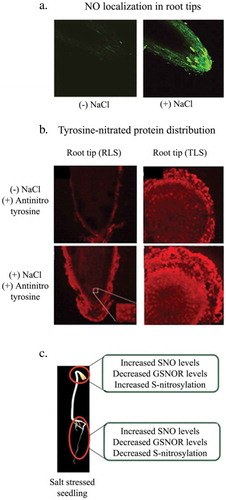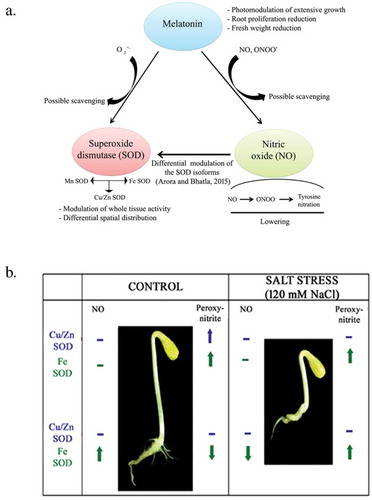Figures & data
Figure 1. (a) Spatial distribution of sodium ions in seedling roots in response to salt (120 mM NaCl) stress, observed using Sodium Green. Profuse accumulation of sodium ions is observed in the meristematically active and elongation zones as a response to NaCl stress (unpublished data). (b). Salt stress–induced expression of oubain-sensitive ATPase in the root tips of 2 day old, dark grown sunflower seedlings. Oubain-sensitive ATPase expression is observed post incubation with 50 µM AO (Anthroyl oubain). Calcium significantly inhibits the expression of oubain-sensitive ATPases. Treatment with calcium ion chelator, EGTA (5 mM) helps in recovery and expression of fluorescence due to enzyme activity in the cells of root tips (Adapted from Mukherjee and Bhatla, 2014).

Figure 2. (a) Temporal distribution of nitric oxide (NO) in roots of 2 day old sunflower seedlings. (Adapted from David et al., 2010). (b). Tyrosine-nitrated protein distribution in 2 day old dark-grown seedlings roots in the absence or presence of NaCl stress enhances tyrosine-nitrated protein distribution in seedling roots in NaCl stress (120 mM) (Adapted from David et al., 2015). (c) S-Nitrosylation of proteins is a mechanism that revolves around the nitric oxide (NO) mediated effects in sunflower seedlings in response to salt (Adapted from Jain et al., 2018).

Figure 3. (a) Interactions among melatonin, nitric oxide and superoxide dismutase (SOD) as a consequence of NaCl (120 mM) stress (Adapted from Arora & Bhatla,2017). (b) Differential modulation of SOD isoforms by NO points toward separate intracellular pathways with their functional separation. Its concentration-dependent biphasic (pro- and antioxidant) nature of action is observed as SOD isoforms are affected variably by the presence of NO (Adapted from Arora and Bhatla, 2015).

